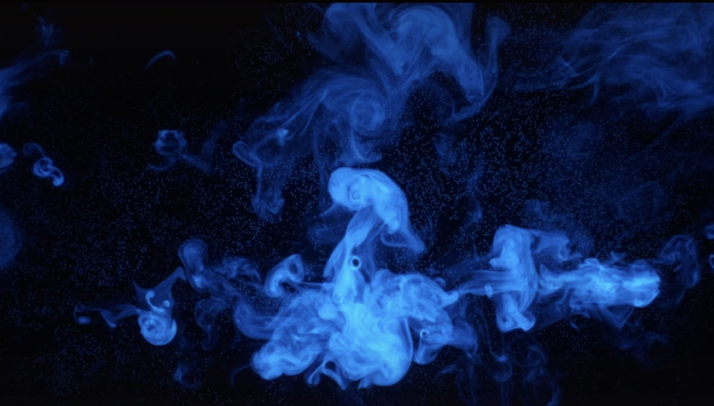| China |
| Beyond the lab | |
|
|
 A screenshot from Hu Shier's video showcasing his capture of the luminol reaction process A screenshot from a content creator's Douyin video, in which he crafts a "flying spider" out of a trash bag alongside his son
The inspiration to photograph the entire chemiluminescent process of the luminol reaction struck a photographer surnamed Hu while he was watching a viral short video documenting the chemical experiment. In the clip, the blue fluorescence from the chemical reaction rippled through flowing liquid reagents like ethereal dancing smoke, creating a mesmerizing interplay of light and shadow. As a professional extreme landscape photographer with a keen sensitivity to light, Hu was instantly captivated. He wanted to film the whole chemical process and upload the clip on his Douyin account, with the username Hu Shier, which has over 150,000 followers. A chemical reaction Previously, his Douyin videos predominantly featured majestic natural scenery—snow-capped mountains, wetlands and tempestuous oceans—rendered in cool, expansive compositions. This time though, he tried something different. He began by studying the reaction's chemical principles, purchased lab equipment, and meticulously rehearsed experimental protocols. "It felt like attending a chemistry crash course," he told China Newsweek magazine. The shoot took place in his office, with colleagues gathering around as all lights were switched off. In the darkness, blue fluorescence erupted as the reagents mixed, morphing hypnotically with the liquid's flow. While photographing rare animals and plants in the wild, he often pushes himself to get closer to his subjects. For the luminol reaction, Hu nearly pressed his lens against the solution. "The camera allows us to get closer and capture details invisible to the human eye," he explained. Colleagues gasped in awe at the view of the chemical effect of the experiment, but Hu's initial shot failed—the fluorescence was so intense it overexposed the camera. After three attempts, he finally tamed the brightness by adjusting reagent quantities. His liberal arts-educated colleagues were astonished that a few milliliters of unremarkable liquid could unleash such radiant energy. "It felt surreal," he said. Recognizing this sense of wonder, Hu shared his photographs of the phenomenon on Douyin. "I want people to know nature's true magic—the beauty defies belief. This luminol reaction is no different," Hu said, continuing that it reminded him of microscopic snowflake photography: "Only when photographers reveal a snowflake's perfect structure do people ask, why is it shaped this way?" For Hu, documenting luminous marvels—natural or chemical—bridges aesthetic wonder and scientific curiosity. His luminol video can be viewed in Douyin's free 4K mode, turning each frame into a wallpaper-worthy glimpse of "details invisible to the naked eye." Another content creator on Douyin, with the username Chao_zip, is also captivated by the luminol reaction. A college junior with over 50,000 Douyin followers—mostly students, he also created a video of this experiment. His video is set to a violin rendition of Serenade in G Major. At one striking moment, the swirling solution trails into a shape resembling a tuxedo's coattail. "It looked like the reaction was dancing to the violin's rhythm," he remarked. The video garnered over 3,000 comments, with many praising how it revealed chemistry's beauty. This resonated with Chao's own journey: Enchanted by classroom chemical wonders in middle school, he grew disillusioned in high school as the subject became "dry symbols on homework and exams." Now, like his viewers, he feels reawakened to chemistry's magic. Music often sparks his creative ideas. Previously, melodies inspired videos about daily life, but after filming the luminol experiment, he began associating music with scientific exploration. "Science is like an open-world game—it makes you want to venture beyond boundaries," he said. He now actively searches Douyin for intriguing chemistry experiments. "As a viewer, I love content that makes knowledge thrilling and sparks curiosity. As a creator, tackling science breaks the limits of my craft," he said.  A screenshot from a content creator's Douyin video, in which he crafts a "flying spider" out of a trash bag alongside his son
Content vs. presentation Chen Yu, a 38-year-old lawyer in Beijing, became fascinated with physics while reading a popular science book on physics with her 10-year-old son. The book, which tells the stories behind physical formulas, captivated her. "This book deconstructs the classic formulas found in textbooks from a unique perspective," Chen told Beijing Review. "It not only reveals the historical context in which formulas were created but also transforms abstract symbols into engaging human narratives through vivid anecdotes about scientists." She believes that this narrative strategy makes complex theories intriguing and accessible. This innovative approach to popularize science has inspired her to take a try. Chen and her son collaborated on a short video about Thomas Edison's inventions, which was well-received in his class for its unique, child-friendly perspective. "In crafting high-quality science content, professional scholars might immerse themselves deeply in their respective fields, whereas we, as 'outsiders,' can discover unique avenues to ignite scientific curiosity through relatable life experiences," she said. On short video platforms, Chen carefully selects family-friendly experiments, such as making a spectroscope from a straw or demonstrating fluid dynamics with food coloring. These simple experiments, using kitchen supplies, not only embody basic physical principles but also turn scientific exploration into a bonding activity. "Every time I see my child's eyes light up with the success of an experiment, I am convinced that this immersive enlightenment is sowing the seeds of future science," she said. According to data from the China Association for Science and Technology, in 2023, 14.14 percent of Chinese citizens possess a basic scientific literacy, more than doubling the figure from 2015. The country has a total of 2.1563 million people working in science popularization, with part-time workers accounting for over 80 percent. Wang Dapeng, an associate research fellow at the China Research Institute for Science Popularization, pointed out that the model of science popularization is undergoing significant changes. The past model of experts unilaterally imparting knowledge has shifted to a "networked sharing" model where everyone can participate in knowledge dissemination. "In an era where people are accustomed to scrolling through short videos and quickly browsing information, science popularizers face a challenge: They must adapt to the characteristics of fragmented reading and grab people's attention with high-quality content," Wang told Science and Technology Daily. "Science popularization short videos must combine scientific core with creative expression to turn complex knowledge into memorable stories." He also warned of negative phenomena emerging in the widespread enthusiasm for public science education in social media: Some chase Internet traffic with clickbait titles, replacing scientific facts with sensational content; some spread unverified claims that let misinformation grow like weeds. "Science communication can use any fun format—jokes, games, even mystery-solving activities—but its core must be precise," Wang said. "If the content's wrong, even the coolest presentation is just digital make-believe—like the Internet version of 'The Emperor's New Clothes'." BR Copyedited by G.P. Wilson Comments to yuanyuan@cicgamericas.com |
|
||||||||||||||||||||||||||||||
|